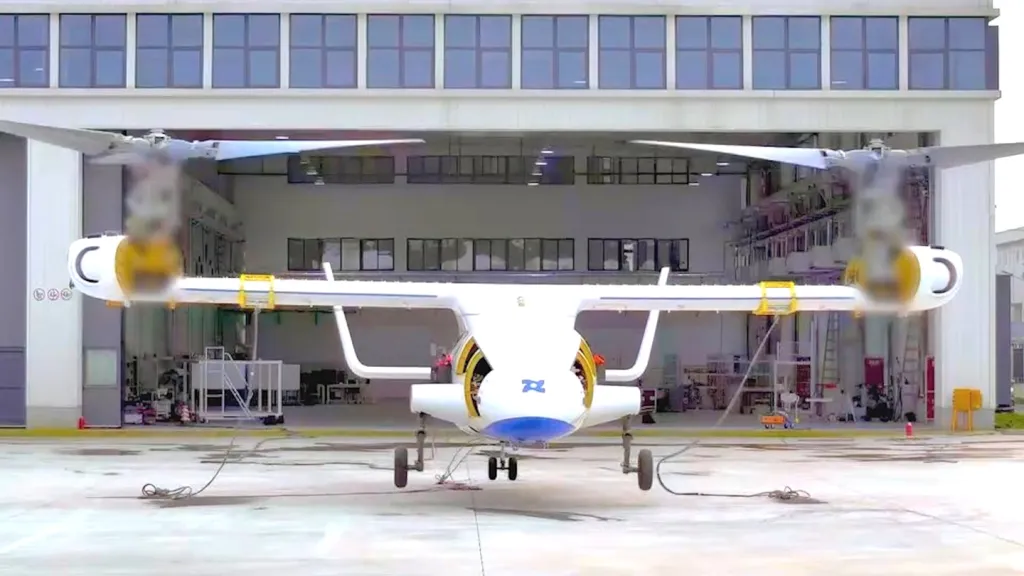Images show that a large tiltrotor drone called the R6000, being developed by United Aircraft in China, has now entered flight testing. The design notably features swiveling rotors that are extremely similar to the ones found on Bell’s V-280 Valor. United Aircraft says it is working on uncrewed and crewed versions of the R6000, primarily for civilian applications, but that also have clear military potential.
Imagery of what is said to be the first tethered hover test of the R6000 first began circulating on social media yesterday, but when exactly the milestone was reached is unknown. Just over a year ago, a picture emerged showing the first completed prototype at the Wuhu United Aircraft Production Workshop in the Wuhu Aviation Industrial Park in China’s eastern Anhui province. United Aircraft unveiled the design, also referred to as the UR6000 and Zhang Ying (or Steel Shadow), at the 2024 Singapore Airshow.
The images of the hover test show various parts of the aircraft stripped down, as well as it lashed to the ground at four points. Tethered hover testing is a common element of initial flight envelope expansion for vertical takeoff and landing designs, especially larger uncrewed ones. Doing so to start offers an additional margin of safety.
The tilting rotor assemblies are notably exposed, but also blurred out in the newly emerged imagery. As mentioned, the design of the R6000’s swiveling rotors looks to be heavily inspired by, if not copied directly from the V-280. The U.S. Army’s future MV-75A tiltrotor, also known as the Future Long-Range Assault Aircraft (FLRAA), is a derivative of the V-280. When Bell first showed the V-280 demonstrator, it also blurred out parts of the rotor assemblies.
Bell has also shown renderings of other tiltrotor concepts in recent years with somewhat similarly configured rotors and nacelles, where only a portion actually pivots up and down. This is distinct from most other tiltrotor concepts, including the U.S. V-22 Osprey, with nacelles that rotate as a complete unit, or even have fully articulating wings.
The rotor and nacelle arrangement seen on the V-280 and now the R6000 is said to offer benefits in terms of reduced complexity and increased reliability, as well as a boost in general performance. Tiltrotor designs are famously complicated, and the V-22’s checkered record is a testament to the challenges this can present. At the same time, tiltrotors offer similar point-to-point flexibility to traditional helicopters, but with the range and speed of a fixed-wing turboprop.
United Aircraft’s website does provide dimensions and other specifications for the R6000, putting it at just under 39 feet long and with a total width (including the wings and rotors) of around 57 feet. The expected maximum takeoff weight is near 13,450 pounds, and it is designed to be able to cruise at just under 297 knots. A maximum range of around 2,485 miles and a mission radius (with an unspecified load) of 932 miles are also projected.
However, it is unclear whether the specifications apply to the uncrewed or crewed version of the design, or both. The specifications do describe a design, broadly speaking, in the same category as the crewed AW609 tiltrotor being developed by Leonardo in Italy, and in a class below the V-22.
United Aircraft has been presenting the R6000’s crewed and uncrewed variations as ideal for moving commercial cargo and as VIP transports, among other non-military roles. A design like this could be well-suited for aeromedical evacuation, especially if it features a pressurized main cabin, and aerial firefighting tasks, as well.
As TWZ discussed in earlier reporting on the R6000, the design also has clear military potential. A tiltrotor design, crewed or uncrewed, that can fly at approaching 300 knots and with a combat radius nearing 1,000 miles would offer a new way to support People’s Liberation Army (PLA) forces at far-flung locations that have limited access via conventional airstrips. For years now, Chinese aviation companies have been pushing ahead with the development of a growing number of fixed-wing logistics drones, which are dependent on at least some form of runway. The PLA has a particularly significant requirement to move cargo and personnel around a constellation of island outposts in the South China Sea. Militarized versions of the R6000 could also support day-to-day operations in other parts of the Pacific, as well as remote locales within China, especially near disputed border areas.
R6000s could also support a variety of PLA expeditionary operational scenarios, including regional ones like an intervention against Taiwan, or missions further from the country’s shores. The design’s payload capacity would open the door to configurations capable of missions beyond logistics, including surveillance and reconnaissance, electronic warfare, signal relay, or even potentially kinetic strike. Tiltotors like the R6000 would also be especially well-suited to operations from the PLA Navy’s growing fleets of big-deck amphibious assault ships. This includes the Sichuan, so far the only example of the super-sized Type 076 design, which just completed its first three-day sea trial.
The R6000 is also just one of several tiltrotor designs, crewed and uncrewed, not in development in China. Just today, a picture said to show another, smaller uncrewed design from United Aircraft emerged online, details about which are currently scant. Pictures showing flight testing of another crewed tiltrotor design, possibly being developed by the Aviation Industry Corporation of China (AVIC), also appeared on social media earlier this year. There are some broad parallels here to recent tiltrotor developments in the United States, which go beyond Bell’s aforementioned V-280 and the V-22.
If nothing else, the start of R6000 flight testing is another example of the continued push by Chinese companies to enter the tiltrotor market space with designs that could be attractive for various military and non-military roles.
Contact the author: joe@twz.com
